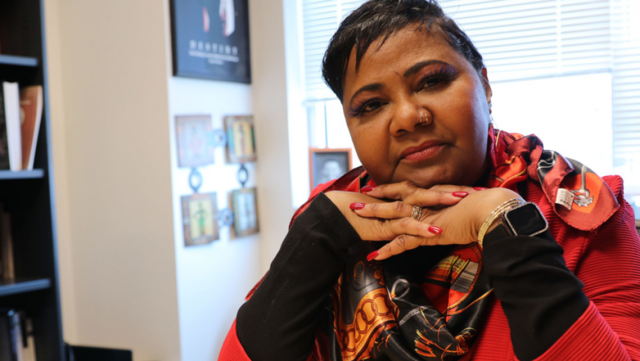I (Ford) was reading a commentary on the top number of “issues” facing education/ educators and became even more outraged and indignant on terminology used to describe children who live in poverty, Blacks, and other minoritized students. My colleagues and I believe this framing and mislabeling are the real ‘issues’, which we use interchangeably with ‘problems’. As minoritized individuals and scholars, we must set the record straight on several real ‘issues/problems’ confronting students of color. We also offer culturally-grounded recommendations for educators to adopt in order to be more effective with low-income students and students of color; in this same spirit, the recommendations are offered to help marginalized students experience schools as affirming places in every level of education. 
Student diversity is not an issue. We must stop (mis)interpreting ‘diversity’ and minoritized students as being so different from white students that they are unteachable and unreachable; that is, educators must stop seeing non-white students as problems and issues to be ‘solved’ rather than taught. Such terminology and subsequent beliefs, behaviors, and actions hinder the ability of educators and decision makers (e.g., teachers, school board members, superintendents, principals) and policy makers to see, appreciate, and honor the cultural capital that students of color bring to education, counseling, and mental health services. Colorblindness/cultureblindness and cultural assaults are unacceptable, to say the least, as delineated below.
a. Counseling & mental health. In school counseling and mental health counseling, counselor educators get extensive preparation in socio-emotional learning (SEL). This is necessary but must include intentional and proactive scholarship and resources on racial identity development. An understanding of racial identity development and pride must be included in all SEL discussions and curricula; and in coursework and professional development. Moreover, school counselors are in a position to impact the academic achievement of students of color, as well as contribute to closing opportunity gaps through collaboration with other school personnel and using data-driven approaches. Further, school counselors must be trained in using an equity-based lens to help students of color explore various career options and postsecondary opportunities in preparation to enter a global, diverse, and technological workforce. Finally, school counselors can assist students by providing short- term mental health services to eliminate obstacles to academic success (American School Counseling Association).
b. Special education over-referrals and overrepresentation. Decades of studies, along with the lived experiences of minoritized families/caregivers demonstrate that racialized/race-based deficit thinking by educators contributes to the unnecessary (over)referrals of minoritized students, especially Black males, Black females, Latinx males, and Latinx females, respectively, to high-incidence and stigmatized special education areas (e.g., intellectual disabilities, emotional and behavioral disorders, learning disabilities, ADHD, developmental delays). When cultural ways of being and cultural differences are framed as assets rather than problems, unnecessary special education referrals, labeling, and placements will decrease.
c. Disciplinary overrepresentation. There is a litany of national, state, and district information – studies and lived experiences -- on the hyper-policing and unjust profiling of Black bodies – at all ages. Even in early childhood, Black boys and girls are inequitably suspended and expelled. The Office for Civil Rights (https://ocrdata.ed.gov/assets/downloads/crdc-DOE-Discipline-Practices-in-Preschool-part1.pdf) paints a truly disturbing picture of the school-to-prison pipeline where our children are adultified; the presumption of innocence is not applied to them. We are reminded of Upchurch’s ‘convicted in the womb’.
d. High-stakes testing and evaluation. Evaluations and decisions based on high-stakes instruments are widespread (e.g., acceptance into accelerated programs such as gifted and talented programs, Honors classes, Advanced Placement, dual enrollment, International Baccalaureate, early kindergarten entrance, STEM, college preparation tracks) are influenced by attitudes, beliefs, preconceptions as it pertains to race, gender, socioeconomic backgrounds, perceived abilities, and values. All professionals who make decisions using test scores must receive training and preparation in test biases and inequities. While intelligence and aptitude tests receive the majority of attention based on our experiences, all instruments need to be interrogated and, scrutinized by racial and ethnic biases. The Association Psychological Association (APA) issued its long-overdue apology for test biases and other impactful and consequential discrimination against Black and other people of color. Since their creation, tests have disproportionately hindered access to gifted and talented education (GATE), AP, college acceptance (particularly to elite higher education institutions), scholarships, and so on.
e. Gifted and talented under-referrals and underrepresentation. Its date of 1933 notwithstanding, Woodson’s Miseducation of the Negro book remains timely and timeless. When denied accessed to needed advanced courses and opportunities, students underachieve, and the Black-white achievement gaps persist. Deficit thinking is undeniably the reason for teachers under-referring Black students for GATE, even when having the same achievement profiles as white students. As implanted, GATE is a form of both ability grouping and tracking. We concur with Oakes’ seminal work, and the National Association of Secondary School Principals (NASSP) view that “… while tracking was originally intended for practical pedagogical purposes, its unintended consequences make it an obsolete practice in the context of high expectations for all. NASSP argues that improving schools involves finding alternatives to tracking by eliminating low-level courses and opening challenging courses to all.”
f. Under-preparation for College and Careers. The culmination of the above inequities collides to ill-prepare minoritized students for higher education admission/acceptance, readiness, and success, as well as being hired and successful in their career. Thus, it is critically important that all students are provided access to a rigorous curriculum in high school to prepare them to be college and/or career ready. This proactive cultural responsiveness and affirmation includes equipping marginalized students with the abilities, skills, and dispositions needed to enhance their core academic content knowledge (e.g., math, science, English), employability skills (e.g., collaboration, critical thinking, problem solving, work ethic), technical skills (e.g., skills needed in specific occupations), and the occupational expression of academic skills (e.g., abilities to translate core academic knowledge to a real-world workplace setting) (Fletcher et al., 2018). These are the necessary skills that students need to successfully make the transition from high school to postsecondary education. Schools can provide this necessary preparation to students by offering accelerated courses/programs, rigorous career and technical education (CTE) programs (e.g., STEM programs/academies), college preparatory and college going activities (e.g., college visits, application preparation, and scholarship information) and work-based learning opportunities (e.g., internships).
“Out with the old. In with the new” is a befitting way to close this commentary. As we begin 2023, it is beyond time for changes. Allies and advocates must be tireless and unrelenting in being anti-racist and culturally responsive professionals and agents of change who want the best for their minoritized students. Giving up on minoritized students is not an option.
Dr. Erik M. Hines is associate professor and program coordinator of counselor education at Florida State University.
Dr. Donna Y. Ford is Distinguished Professor of Education and Human Ecology at The Ohio State University
Dr. Tanya J. Middleton is a clinical assistant professor in the Department of Educational Studies at The Ohio State University
Dr. Edward C. Fletcher Jr., is the Education and Human Ecology Distinguished Professor in the Department of Educational Studies at The Ohio State University.
Recommendations
The recommendations below capture and reinforce what we have argued for as Black professionals dedicated to equity, anti-racism, and cultural competence. Our commitment is professional and personal. Passiveness and apathy do little to help correct and eliminate inequities at individual and systemic levels.
- More representation of minoritized professionals is needed in P-12 and higher education. #RepresentationMatters
- Higher ed coursework is needed in all disciplines focused on anti-racism and cultural competence. #PreparationMatters
- Professional development on anti-racism and cultural competence must be provided with required (non-optional) attendance. #TrainingMatters
- Educators must check their biases and beliefs about students of color and their families to better serve and assist them. #BeliefsMatter.
- Increase interactions with students and families of color during and outside of school. An example is attending community events. #InteractionMatters
- Educators must understand the role that adultification plays in increasing punitive or harsh punishments for students of color, in particular, Black boys (Hines et al., 2021). #StopAdultification
- Be proactive by taking charge of one’s own learning to avoid being miseducated and miseducating. Educators must not be passive recipients of their learning, Read the work of scholars of color. Also, there is no shortage of culturally-based educational opportunities – attend conferences by minoritized professionals and organizations; enroll in courses. #BeProactive
- Administrators can utilize their school counselors to bridge partnerships between the school and parents and students of color as they are trained in cultural responsiveness. #LeadershipMatters
- Empathy and caring should be staples in an educator’s skill set to understand the issues students of color encounter rather than dismissing their experiences or feelings, and rather than viewing such students as issues and problems. #EmpathyMatters
- High expectations of students of color, especially around pursuing postsecondary opportunities, should be the norm and not the exceptions (Hines & Owen, 2022; Sewell & Goings, 2022). These norms should include offering accelerated courses/programs, rigorous career and technical education (CTE) programs (e.g., STEM programs/ academies), college preparatory and college going activities (e.g., college visits, application preparation, and scholarship information) and work-based learning opportunities (e.g., internships). #HighExpectationsMatter
References/Resources
Fletcher, E.C., Warren, N., & Hernandez-Gantes, V.M. (2018). Preparing high school
students for a changing world: College, career, and future ready learners. Career and Technical Education Research, 43(1), 77-98. doi:10.5328/cter43.1.77.
Hines, E.M., Fletcher, E.C., Ford, D.Y., & Moore III, J.L. (2021). Preserving Innocence:
Ending adultification and toxic masculinity among Black boys. Journal of Family
Strengths, 21(1). 1-11.
Hines, E.M. & Owen, L. (Eds.). (2022). Equity-based career development and postsecondary
transitions: An American imperative. Information Age Publishing.
Sewell, C.J. & Goings, R.B. (2020). "I Struggled but I Made It": Black Gifted
Underachievers on Transitioning to College https://eric.ed.gov/?id=EJ1250239&fbclid=IwAR2u-UnzL7Dv9Txya53qqG_Hib2zemeH9BSzWMnKcPcxCDX32ziLMYkWZhY


















